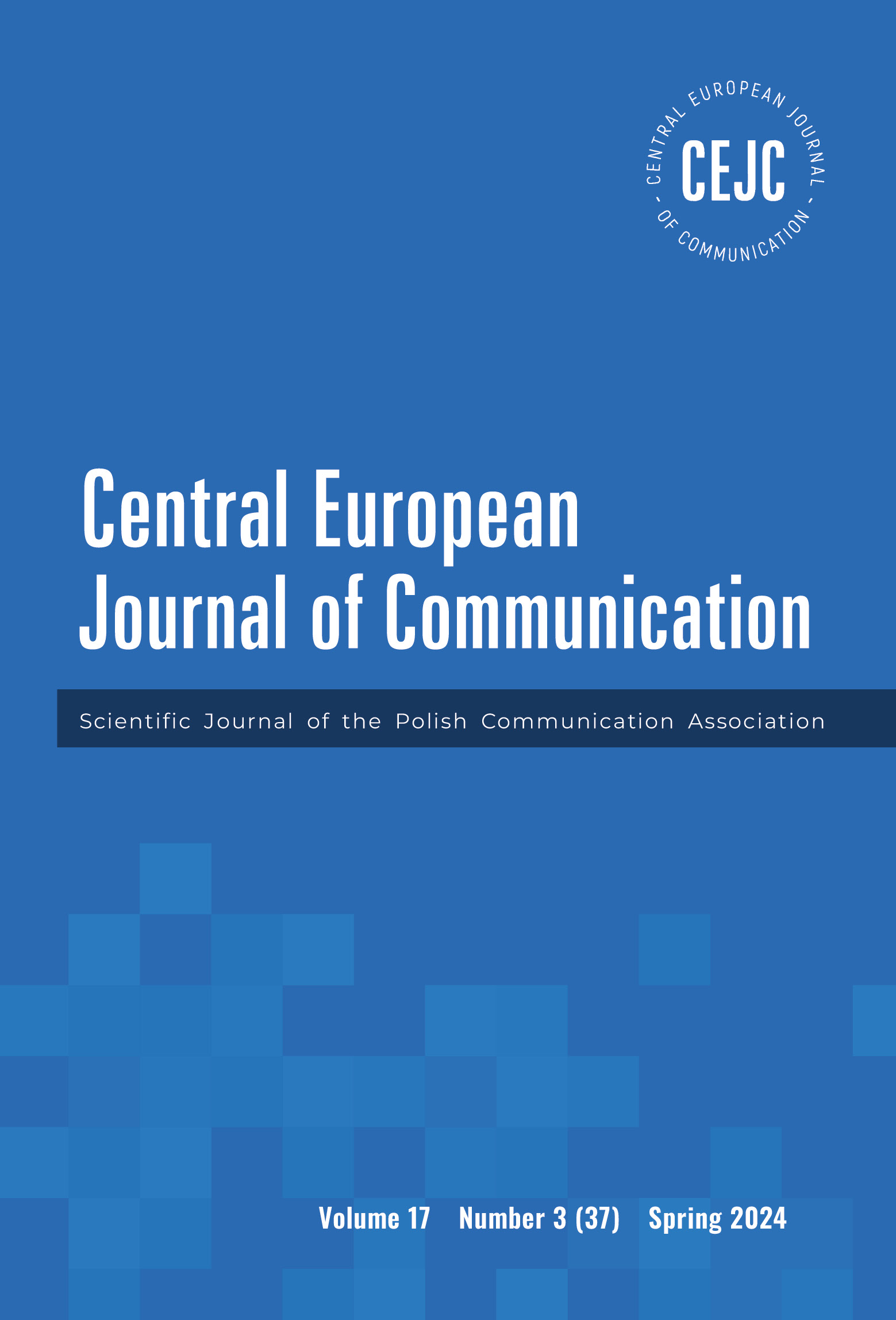Fact-Checkers as a Professional Community of Experts. The Research Project – From Idea to Implementation
DOI:
https://doi.org/10.51480/1899-5101.17.3(37).639Keywords:
fact-checking, discursive community, professionalisation, disinformation, methodological model, IDIAbstract
The following article presents an elaborate methodological concept that, in perspective, can serve as a model for analyzing professional communities (such as journalists) understood primarily as symbolic and discursive communities. This concept was partially tested by the author during her research on the community of fact-checkers (FC) in Poland. This study used in-depth interviews. The article presents the research design and its implementation, as well as the preliminary generalized results of the study. Special attention is paid to the usefulness of the IDI method in the context of professional community research, and to the difficulties that may be associated with the use of this method.
References
Arbiszewski, K. (2012). Poznanie, zbiorowość, polityka. Analiza teorii aktora-sieci Bruno Latoura. (Cognition, collectivity, politics. An analysis of Bruno Latour’s actor-network theory). Universitas: Kraków.
Bourdieu, P. (2007). Reguły sztuki. Geneza i struktura pola literackiego. (The Rules of Art. Genesis and Structure of the Literary Field). Universitas: Kraków
Cambridge Dictionary (2024) https://dictionary.cambridge.org/dictionary/english/fact-checking
Carlson, M. (2016). Metajournalistic Discourse and the Meanings of Journalism: Definitional Control, Boundary Work, and Legitimation. Communication Theory, vol. 26, no. 4, 349–368. https://doi.org/10.1111/comt.12088
Carlson, M., & Lewis S. C., (Eds). (2015). Boundaries of Journalism. Routledge: London–New York 2015.
Carpentier, N. (2005). Identity, contingency and rigidity. The (counter-)hegemonic constructions of the identity of the media professional. Journalism 6, 199–219. DOI:10.1177/1464884905051008
Deuze, M. (2004). Journalism studies beyond media: On ideology and identity. Ecquid Novi African Journalism Studies, 25, 275–293. DOI:10.1080/02560054.2004.9653298
Fiske, J. (2010). Reading the popular. Taylor & Francis Ltd.: London.
Foucault, M. (1977). Archeologia wiedzy. (Archeology of Knowledge). PIW: Warszawa.
Foucault, M. (1980). Power/Knowledge: selected interviews and other writings 1972 – 1977. Hemel Hempstead: Harvester Wheatsheaf.
Giddens, Anthony. (2001). Nowoczesność i tożsamość. „Ja” i społeczeństwo w epoce późnej nowoczesności. (Modernity and self-identity). PWN: Warszawa.
Jewitt, C. (ed.). (2014). The Routledge Handbook of Multimodal Analysis. Taylor&Francis Ltd.: London.
Kawa, A. (2014). Analiza sieciowa jako metoda badawcza w naukach o zarządzaniu. (Network analysis as a research method in management science. Prace Naukowe Uniwersytetu Ekonomicznego we Wrocławiu 356, 40–49.
Kong, K. (2014). Professional Discourse, Cambridge University Press: Cambridge.
Laclau, E,. & Mouffe, C. (2007). Hegemonia i socjalistyczna strategia. (Hegemony and socialist strategy). Wydawnictwo Naukowe Dolnośląskiej Szkoły Wyższej we Wrocławiu: Wrocław.
Maison, D. (2001). Zogniskowane wywiady grupowe. (Focus group interviews). Warszawa: PWN.
McCombs, M., Shaw, D., & Weaver, D. (2014). New directions in agenda-setting theory and research. Mass Communication and Society, Vol. 17, no 6. https://doi.org/10.1080/15205436.2014.964871
Meltzer, K., & Martik, E. (2017). Journalists as Communities of Practice: Advancing a Theoretical Framework for Understanding Journalism. Journal of Communication Inquiry, 41(3), 207–226. https://doi.org/10.1177/0196859917706158
Pawlikowska, A. (2012). Zastosowanie metod językoznawstwa korpusowego i lingwistyki kwantytatywnej w analizie dyskursu. (Application of methods of corpus linguistics and quantitative linguistics in discourse analysis). Oblicza Komunikacji, 5, 111–125.
Poynter (2024) https://www.poynter.org/ifcn/articles-ifcn/
Stasiuk‑Krajewska, K. (2018). Media i dziennikarstwo. Struktury dyskursu i hegemonia. (Media and journalism. Discourse structures and hegemony). Elipsa: Warszawa.
Stasiuk‑Krajewska, K. (2021). Informacja jako gatunek medialny. (Information as a media genre). Życzyński, Norbert, Tworzydło, Dariusz, Gawroński, Sławomir (ed.). Informacje prasowe. Czynniki determinujące skuteczne relacje z mediami. (Press releases. Factors determining effective media relations). Wydawnictwo Politechniki Rzeszowskiej: Rzeszów.
Stasiuk‑Krajewska, K (2024). „Fact-check” jako praktyka dyskursywna. Prób opisania nowego gatunku medialnego. (“Fact-check” as a discursive practice. Attempts to describe a new media genre). Rozbicka, Patrycja, Gołuch, Wiesław (ed.). Co pan na to, panie P? (What do you think, Mr. P. Wydawnictwo Uniwersytet Wrocławskiego: Wrocław
Stencel, M., Ryan, E. & Luther, J. (2023). Misinformation spreads, but fact-checking has leveled off. 10th annual fact-checking census from the Reporters’ Lab tracks an ongoing slowdown. https://reporterslab.org/misinformation-spreads-but-fact-checking-has-leveled-off/.
Swales, J. (1990). Genre analysis: English in academic and research settings. Cambridge University Press: Cambridge.
Warnke, I. & Spitzmüller, J. (2009). Wielopoziomowa lingwistyczna analiza dyskursu – DIMEAN. (Multilevel linguistic discourse analysis – DIMEAN). Tekst i dyskurs, no 2, 143–44.
Wenger, E. (1998). Communities of practice. Learning, meaning and identity. Cambridge University Press: Cambridge.
Downloads
Published
How to Cite
Issue
Section
License
Copyright (c) 2025 Polish Communication Association

This work is licensed under a Creative Commons Attribution-ShareAlike 4.0 International License.


